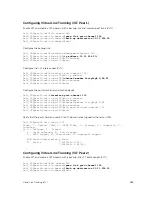
Specifying VLT Nodes in a PVLAN
You can configure VLT peer nodes in a private VLAN (PVLAN). VLT enables redundancy without the
implementation of Spanning Tree Protocol (STP), and provides a loop-free network with optimal
bandwidth utilization.
Because the VLT LAG interfaces are terminated on two different nodes, PVLAN configuration of VLT
VLANs and VLT LAGs are symmetrical and identical on both the VLT peers. PVLANs provide Layer 2
isolation between ports within the same VLAN. A PVLAN partitions a traditional VLAN into sub-domains
identified by a primary and secondary VLAN pair. With VLT being a Layer 2 redundancy mechanism,
support for configuration of VLT nodes in a PVLAN enables Layer 2 security functionalities. To achieve
maximum VLT resiliency, you should configure the PVLAN IDs and mappings to be identical on both the
VLT peer nodes.
The association of PVLAN with the VLT LAG must also be identical. After the VLT LAG is configured to be
a member of either the primary or secondary PVLAN (which is associated with the primary), ICL becomes
an automatic member of that PVLAN on both switches. This association helps the PVLAN data flow
received on one VLT peer for a VLT LAG to be transmitted on that VLT LAG from the peer.
You can associate either a VLT VLAN or a VLT LAG to a PVLAN. First configure the VLT interconnect (VLTi)
or a VLT LAG by using the
peer-link port-channel
id-number
command or the VLT VLAN by using
the
peer-link port-channel
id-number
peer-down-vlan vlan
interface number
command
and the
switchport
command. After you specify the VLTi link and VLT LAGs, you can associate the
same port channel or LAG bundle that is a part of a VLT to a PVLAN by using the
interface
interface
and
switchport mode private-vlan
commands.
When a VLTi port in trunk mode is a member of symmetric VLT PVLANs, the PVLAN packets are
forwarded only if the PVLAN settings of both the VLT nodes are identical. You can configure the VLTi in
trunk mode to be a member of non-VLT PVLANs if the VLTi is configured on both the peers. MAC address
synchronization is performed for VLT PVLANs across peers in a VLT domain.
Keep the following points in mind when you configure VLT nodes in a PVLAN:
• Configure the VLTi link to be in trunk mode. Do not configure the VLTi link to be in access or
promiscuous mode.
• You can configure a VLT LAG or port channel to be in trunk, access, or promiscuous port modes
when you include the VLT LAG in a PVLAN. The VLT LAG settings must be the same on both the peers.
If you configure a VLT LAG as a trunk port, you can associate that LAG to be a member of a normal
VLAN or a PVLAN. If you configure a VLT LAG to be a promiscuous port, you can configure that LAG
to be a member of PVLAN only. If you configure a VLT LAG to be in access port mode, you can add
that LAG to be a member of the secondary VLAN only.
• ARP entries are synchronized even when a mismatch occurs in the PVLAN mode of a VLT LAG.
Any VLAN that contains at least one VLT port as a member is treated as a VLT VLAN. You can configure a
VLT VLAN to be a primary, secondary, or a normal VLAN. However, the VLT VLAN configuration must be
symmetrical across peers. If the VLT LAG is tagged to any one of the primary or secondary VLANs of a
PVLAN, then both the primary and secondary VLANs are considered as VLT VLANs.
If you add an ICL or VLTi link as a member of a primary VLAN, the ICL becomes a part of the primary
VLAN and its associated secondary VLANs, similar to the behavior for normal trunk ports. VLAN parity is
Virtual Link Trunking (VLT)
887
Summary of Contents for Z9000
Page 1: ...Dell Configuration Guide for the Z9000 System 9 7 0 0 ...
Page 80: ...grub reboot 80 Management ...
Page 128: ... 0 Te 1 1 Te 1 2 rx Flow N A N A 128 Access Control Lists ACLs ...
Page 491: ...Figure 70 Configuring OSPF and BGP for MSDP Multicast Source Discovery Protocol MSDP 491 ...
Page 496: ...Figure 73 MSDP Default Peer Scenario 1 496 Multicast Source Discovery Protocol MSDP ...
Page 497: ...Figure 74 MSDP Default Peer Scenario 2 Multicast Source Discovery Protocol MSDP 497 ...
Page 498: ...Figure 75 MSDP Default Peer Scenario 3 498 Multicast Source Discovery Protocol MSDP ...
Page 760: ...Figure 100 Single and Double Tag TPID Match 760 Service Provider Bridging ...
Page 761: ...Figure 101 Single and Double Tag First byte TPID Match Service Provider Bridging 761 ...















































